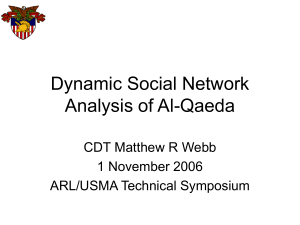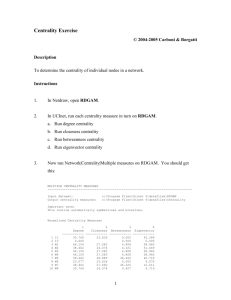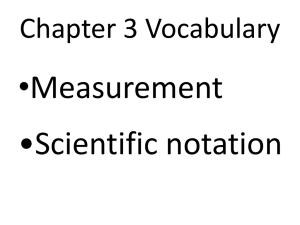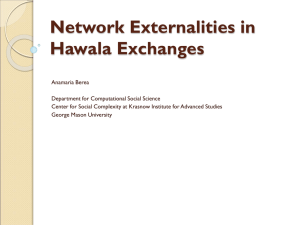Interesting applications of Decision Maths Decision Maths?
advertisement
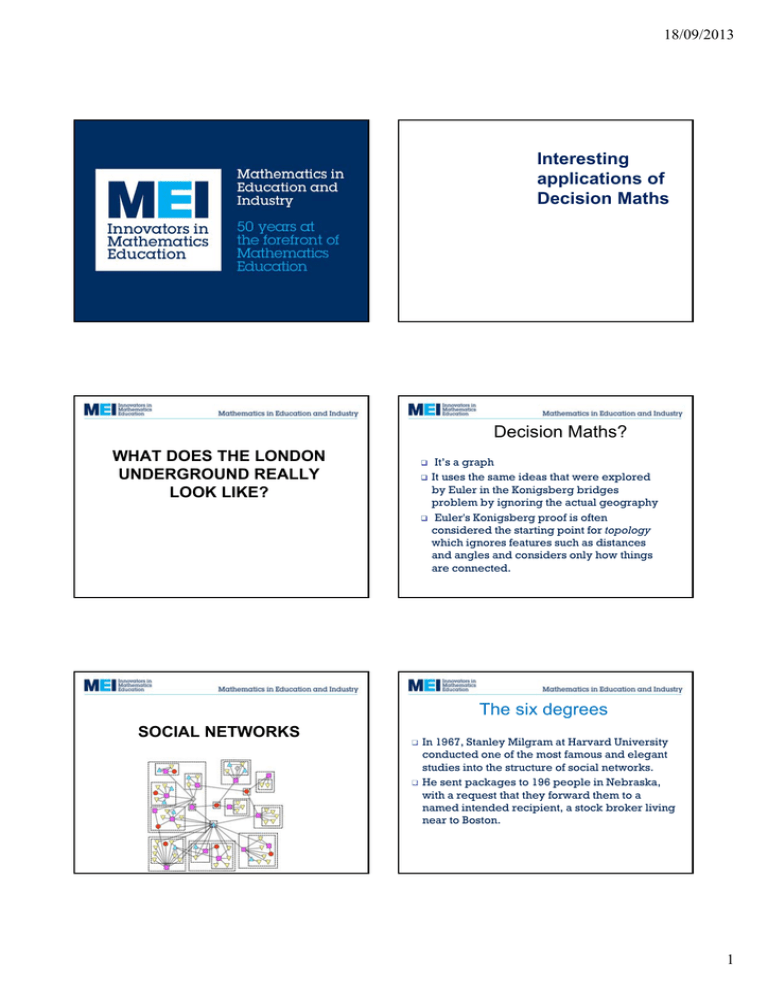
18/09/2013 Interesting applications of Decision Maths Decision Maths? WHAT DOES THE LONDON UNDERGROUND REALLY LOOK LIKE? It’s a graph It uses the same ideas that were explored by Euler in the Konigsberg bridges problem by ignoring the actual geography Euler's Konigsberg proof is often considered the starting point for topology which ignores features such as distances and angles and considers only how things are connected. The six degrees SOCIAL NETWORKS In 1967, Stanley Milgram at Harvard University conducted one of the most famous and elegant studies into the structure of social networks. He sent packages to 196 people in Nebraska, with a request that they forward them to a named intended recipient, a stock broker living near to Boston. 1 18/09/2013 The six degrees Milgram found that on average just six journeys were needed before the packages found their way to the right person. Bacon The Bacon Number is the smallest number of movies that link an actor with Kevin Bacon. An actor who has been in a movie with Kevin Bacon has a Bacon Number of 1 If your Bacon Number is not 1 but you’ve been in a movie with someone who has been in a movie with Kevin then your Bacon Number is 2 Social Networks Erdos Mathematicians have their own version of this game! Network Centrality: Who is the most central person in this network? a) Get your facebook analytics report at http://www.wolframalpha.com/facebook/ Degree Centrality This ranks centrality by the degree of the node Diane 3 b) Heather 5 4 c) Garth/Fern 6 4 3 2 1 5 3 2 18/09/2013 Degree Centrality This simply ranks centrality by the degree of the node Closeness Centrality For each person calculate the average length of the shortest path to all the other people in the network Diane (6) 3 Fern/Gareth (5) 5 4 6 Andre/Bev (4) 3 4 2 1 Carol/Ed/Heather (3) 5 Ike (2) 3 Jane (1) Closeness Centrality For each person calculate the average length of the shortest path to all the other people in the network. 1+ Closeness Centrality 1+1+1 Closeness Centrality 1+1 Closeness Centrality 1+1+1+1 3 18/09/2013 Closeness Centrality 1+1+1+1+2 Closeness Centrality 1+1+1+1+2+2+2 Closeness Centrality 1+1+1+1+2+2+2 + 3 + 4 = 17 Closeness Centrality 1+1+1+1+2+2 Closeness Centrality 1+1+1+1+2+2+2 +3 Closeness Centrality 17/9 = 1.88 4 18/09/2013 Closeness Centrality A – 1.88 B – 1.88 C – 2.0 D – 1.67 E – 2.0 F – 1.56 G – 1.56 H – 1.67 I – 2.33 J – 3.22 Between-ness Centrality Closeness centrality Closeness centrality measures the average social distance from each individual to every other individual in the network. High closeness centrality individuals tend to be important influencers within their local network community. . List of all shortest paths Take all the shortest paths in the network (Floyd’s algorithm will give this) For each node, count how many of the shortest paths it’s on. A–2 A–2 B–2 5 18/09/2013 A–2 B–2 C-0 A–2 B–2 C–0 D–3 v v A–2 B–2 C–0 D–3 E–0 A–2 B–2 C–0 D–3 E–0 F–9 v v v v v v v v v v A–2 B–2 C–0 D–4 E–0 F–9 G–6 v v v v v v v v v v v v v v v v v A–2 B–2 C–0 D–4 E–0 F–9 G–6 H – 12 v v 6 18/09/2013 A–2 B–2 C–0 D–3 E–0 F–9 G–6 H – 12 I–7 v v v v v A–2 B–2 C–0 D–3 E–0 F–9 G–6 H – 12 I–7 J–0 v v A – 0.833 B – 0.833 C–0 D–2 E–0 F – 7.5 G – 7.5 H – 12 I–7 J–0 Degree Centrality Closeness Centrality Between-ness Centrality Heather Diane Heather Fern/Gareth Fern/Gareth Fern/Gareth Fern/Gareth Diane/Heather Ike Andre/Bev Ike Andre/Bev Diane Heather/Carol/ Ed Diane Carol/Ed Andre/Bev Ike Carol/Ed/Jane Jane Andre/Bev Carol/Ed/Jane Betweenness centrality These are individuals who are necessary conduits for information that must traverse parts of the network. These are usually different individuals from those with high closeness. High betweenness individuals often do not have the shortest average path to everyone else, but they do have the greatest number of shortest paths that necessarily have to go through them. Ike Jane UNUSUAL APPLICATIONS OF DIJKSTRA’S ALGORITHM (OR HOW TO CATCH A BADDIE 7 18/09/2013 Applications of Dijkstra's Algorithm Edsgar Dijkstra Traffic Information Systems Mapping (Google Maps) Routing Systems Social Networks "Computer Science is no more about computers than astronomy is about telescopes." http://www.cs.utexas.edu/~EWD/ Applications of Dijkstra's Algorithm Epidemiologists use networks to model the spread of infectious diseases and design prevention and response strategies. Vertices represent individuals, and edges their possible contacts. It is useful to calculate how a particular individual is connected to others. Knowing the shortest path lengths to other individuals can be a relevant indicator of the potential of a particular individual to infect others. A* Pursuit Algorithm Now, about those baddies The algorithm in action! 8 18/09/2013 FIND YOUR PERFECT PARTNER Game theory and dating If you are choosing a long term partner you have to weigh two opposing factors. If you pick someone too early, you are making a decision without checking out your options. You might get lucky, but it’s a big risk. If you wait too long, you leave yourself with only a few candidates to pick from. Again, this is a risky strategy. The game boils down to selecting an optimal stopping time between playing the field and holding out too long. What does the maths say? Game theory and dating One approach is to select the first relationship, but what’s the chance that the first person is the best? It is equally likely for the first person to be the best, the second best, or the worst. This means by pure luck you have a 1/3 chance of finding true love if you always pick the first person. You also have a 1/3 chance if you always pick the last person, or always pick the second. Can you do better than pure luck? Game theory and dating Consider the following strategy: get to know–but always reject–the first person. Then, select the next person you think is better than the first person (till you run out of people) How often does this strategy find the best overall person? Game theory and dating DATING RULES You only date one person at a time. A relationship either ends with you “rejecting” or “selecting” the other person. If you “reject” someone, the person is gone forever. Sorry, old flames cannot be rekindled. You plan on dating some fixed number of people (N) during your lifetime. As you date people, you can only tell if the second person was better than the first person, but you cannot judge whether the second person is your true love. After all, there are people you have not dated yet. Game theory and dating There are 6 possible dating orders 9 18/09/2013 1 2 3 Lose Game theory 1 3 2 Lose the strategy wins in three cases. 2 1 3 Win is the study of mathematical models of conflict and cooperation between intelligent rational decision-makers. the idea of GAME THEORY is to decide whether or not there is a strategy you can play that gives you a good chance of success. It’s origins are in the 18th Century, but it was famously driven forward by mathematicians John von Neumann and John Nash in the 1940s and 1950s. 2 3 1 Win 3 1 2 Win 3 2 1 Lose It turns out it wins 50 percent of the time! Golden Balls SHOULD YOU ASK THE AUDIENCE? TV show from Feb 2008 to Feb 2009 where a jackpot is to be shared between 2 contestants who secretly choose to "split" or "steal". Rules 1. If both players "split", the jackpot is split equally between them. 2. If 1 player "splits" and the other "steals", the stealer gets the whole jackpot and the splitter leaves with nothing. 3. If both players "steal", they both leave with nothing. Golden Balls Should you ask the audience? Player B Player A Split Split £150000 Steal (50,50) (0,100) Steal (100,0) (0,0) While cooperation is collectively rational, defection is individually rational. maybe 0.5 £1000 (safety net) £2000 £100000 £5000 £10000 maybe 0.5 £20000 £50000 (safety net) Pretty sure 0.75 £75000 £125000 250000 £500000 Not sure 0.25 £1000000 £50000 £150000 £50000 10 18/09/2013 Utility Abi owes £10000 on her credit card Bob would like £50000 to pay off his mortgage Carl owns 2 houses and a Porsche WHY AM I ALWAYS IN THE SLOWEST QUEUE? Why am I always in the slowest queue? http://www.yousimul8.com/ http://www.yousimul8.com/search.php?search _text=supermarket+sweep&x=23&y=8 11
